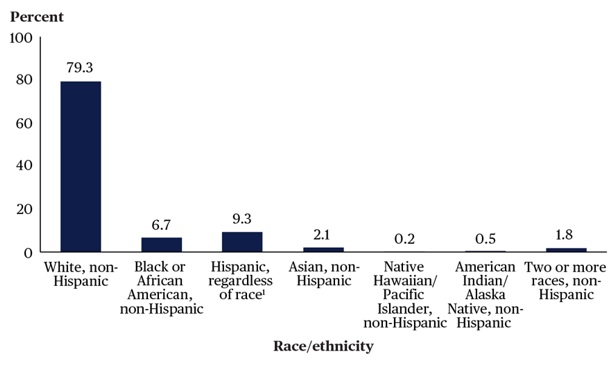
Do you know, according to the National Center for Education Statistics, 79% of the nation's teaching force is white, 7% are Black/African American, 9% are Hispanic, 2% are Asian, and 2% are of two or more ethnicities?

In a rapidly diversifying world, teachers of color hold an invaluable place within the education system. Despite their crucial roles, they often face challenges like "invisible taxes", additional burdens of emotional labor, and diversity expertise that remain unseen and unacknowledged.
This pressure leads many to leave the profession sooner than their white peers. To support these educators effectively, it's vital to recognize their unique struggles and foster environments that celebrate and empower their contributions.
Let’s get to know how we can together nurture inclusive and equitable educational experiences for all.
Importance of Supporting Teachers of Color
Supporting teachers of color is a crucial step toward transforming the educational landscape for the better. As the backbone of diverse, inclusive, and inspiring classrooms, these educators bring unique perspectives and experiences that resonate with students from all backgrounds. The effects of their presence and contributions go far beyond academic achievements, establishing foundations for future opportunities and bridging cultural gaps.
Role of Teachers of Color in Education
Teachers from different backgrounds, colors, and ethnicity plays a significant role in education by serving as role models, closing achievement gaps, and improving learning for all students. Research shows that students of color benefit greatly when they see themselves reflected in their teachers.
This representation fosters a sense of belonging and relatability, resulting in higher academic success and increased engagement. Moreover, they challenge implicit biases, offering insights into diverse cultures and advocating for equity and understanding in educational settings.
Challenges Faced by Teachers of Color
While their impact is profound, teachers of color face a myriad of challenges that can hinder their ability to thrive and make a lasting difference. Understanding and addressing these obstacles is essential in ensuring their success and retention in the profession.
Many teachers of color enter the profession already burdened with significant financial strain. Low starting salaries combined with personal financial responsibilities often lead to burnout. This financial pressure is compounded by the expectation to take on unpaid, emotionally demanding roles, intensifying their stress and dissatisfaction.
Teachers of color frequently feel an "invisible tax" placed upon them, where they are expected to carry the additional emotional labor and diversity-related responsibilities for their entire institution. Such pressure can be overwhelming, as their unique insights and competencies are often pigeonholed.
The retention rates of different races, colors, and ethnicity teachers are significantly lower than their white counterparts, driven by a cycle of burnout, financial challenges, and lack of support.
Unwelcoming work environments and inadequate preparation further contribute to their departure, exacerbating the diversity gap in educational institutions. Addressing these issues requires collective responsibility and systemic support from all educational stakeholders.
Strategies to Support Teachers of Color
Let’s get to know some of the effective strategies for supporting teachers of color:
The journey to support teachers of color begins with sharing responsibilities equally among all educators. Many renowned teachers like Arielle Miller often find themselves bearing the weight of additional tasks because of their racial identity, an invisible tax that can lead to burnout and early exits from the profession.
To change this, schools should hire specialists dedicated to diversity and inclusion and distribute tasks equitably. This approach allows teachers of color to focus on empowering students without the added pressure of being the sole advocate for minority issues.
Schools can aim to hire teachers from a variety of backgrounds, including those identifying as LGBTQ+, neurodivergent, or belonging to other minority groups. By reflecting the diversity of the student body, schools can create a more inclusive environment where every voice is heard and valued.
Efforts to diversify the teaching workforce can be enhanced by targeting historically Black colleges and universities and other institutions with significant minority representation.
Creating welcoming environments for teachers of color is crucial. Schools should focus on establishing programs that embrace the unique perspectives these educators bring, making sure they feel included and valued from day one.
Creating a Supportive Environment For Teachers of Color
Let’s get to know some of the effective ways to create a supportive environment for teachers of color:
One effective way to create a supportive environment for teachers of color is by partnering with community organizations that specialize in race, culture, and identity. These partnerships can provide valuable resources and support systems that help create inclusive atmospheres where educators and students alike can thrive.
Hiring teachers of color earlier in the year can significantly improve their chances of securing roles. By being proactive in the recruitment process, schools have the opportunity to attract top candidates who are often in high demand. Early hiring not only fills positions more effectively but also sets the stage for a smoother onboarding process that acknowledges and utilizes the strengths of these educators.
Providing Mentorship and Assistance
Supporting teachers of color through mentorship and assistance is crucial in their first year and beyond. Schools can pair new teachers with experienced mentors who guide and support them through the challenges they face. Providing additional assistance and encouraging collaboration fosters a sense of belonging and ensures that teachers of color feel their contributions are recognized and valued. Such efforts are essential in building a nurturing and empowering environment where these educators can flourish, ultimately benefiting students and the broader community.
Final Thoughts
Supporting teachers of color is a vital step toward creating an educational system that truly embraces diversity and equity. By understanding the unique challenges they face and taking actionable steps, schools can foster an environment where these educators thrive.
By creating a diverse environment, sharing responsibilities equitably, and recognizing the invaluable role teachers of color play in enriching the whole education community. Together, we can build a brighter, more inclusive future for all students, ensuring that every teacher feels seen, valued, and empowered. Become a catalyst for change and a beacon of hope by pursuing courses like the Online teacher training programs in UAE in the education landscape.
We believe education should be accessible for everyone. That’s why we don’t charge for our blogs. Find the right course that will help you in your career with us, contact us at - 8000180858. You can mail us at act@asiancollegeofteachers.com.